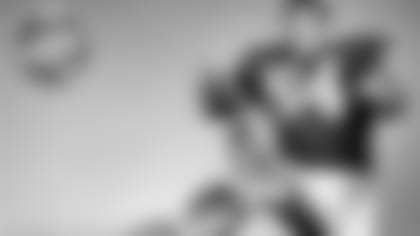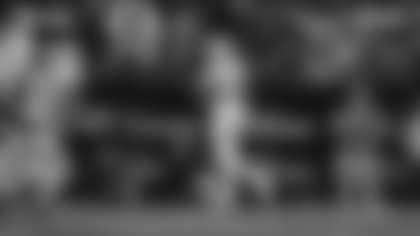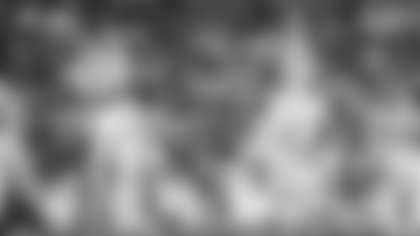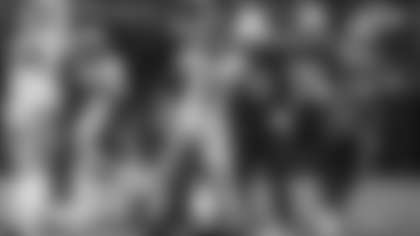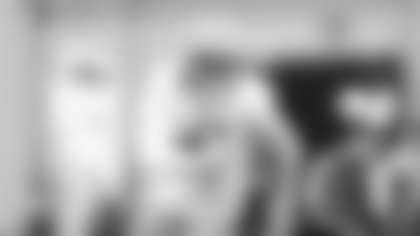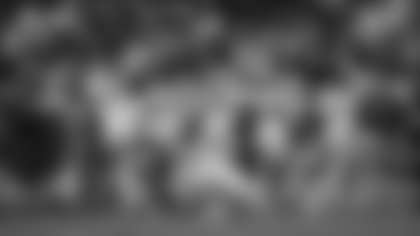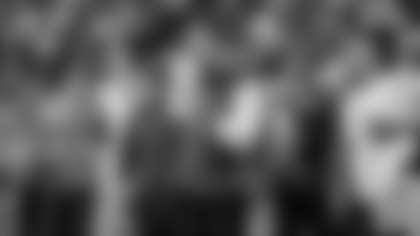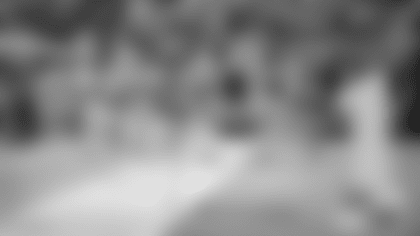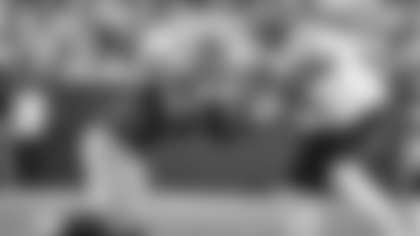Scott from Phoenix, AZ
Why did Lombardi split the 1962 placekicking between Jerry Kramer and Paul Hornung?
Good question. Simple question. And with Kramer now being a Pro Football Hall of Fame finalist again, the subject will become even more topical than when you submitted it. So you had me digging through the official game reports and play-by-plays because I knew the answer wouldn't be simple.
Hornung injured his knee in the first quarter of the fifth game of the season against Minnesota and attempted only one field goal thereafter. He also missed five games. Hornung scored the first touchdown and converted the extra point against the Vikings before Kramer took over the kicking duties and made two field goals and five extra points over the remainder of the Packers' 48-21 victory.
Always a good quote, Kramer joked with reporters in the locker room afterward. "How about that?" he said. "The only knuckleball kicker in the league."
At that point, Kramer hadn't kicked in a game since the 1958 preseason. But he ended up making 9 of 11 field-goal attempts and 38 of 39 extra points over the final 10 games, as well as his three field goals from 26, 29 and 30 yards in the Packers' 16-7 victory over the New York Giants in the 1962 NFL Championship Game. While those field goals would seem like chip shots today, they were anything but in the howling winds and frigid temperatures of Yankee Stadium.
Interestingly, safety Willie Wood did most of the kicking off the rest of the season, although Kramer did some, as well, and handled the chore exclusively in two games.
Kramer served as the Packers' placekicker again in 1963 when Hornung was suspended. Hornung took back the job in 1964, but had a bad year and Vince Lombardi acquired kicking specialist Don Chandler during the offseason to replace Hornung. Thus, Kramer didn't kick again until 1968, the year after Chandler retired, when he handled the duties for most of the first five games. In all, the Packers used four different kickers that season – Chuck Mercein, Errol Mann and Mike Mercer followed Kramer – and converted only 13 of 29 field-goal tries.
While Kramer kicked only 29 field goals during his career and was basically a fill-in when he handled the duties, his contributions as a kicker should be considered a plus on his Hall of Fame resume.
In 1962, Kramer was the only starting offensive lineman in the league who doubled as a kicker and he filled that role for the league champions with an accuracy mark of 81.8 percent. That year, half of the 14 NFL teams had what was essentially a kicking specialist and only two of the seven made better than 50 percent of their field-goal attempts. Chandler, then with the New York Giants, had the best percentage among the specialists at 67.9.
Over his career, Kramer made 53.7 percent of his field-goal tries. Lou Groza was a starting offensive lineman and kicker for Cleveland for the first 14 years of his career and then basically a kicking specialist for the last seven. Thus, he was inducted into the Pro Football Hall of Fame as both a tackle and kicker. His career field goal percentage was 54.9, barely better than Kramer's.
Not only were Groza and Kramer, and Hornung for that matter, straight-on kickers, but they were often on the field for every offensive down before they were called on for field-goal and extra-point tries. What's more, the hash marks were wider and the angles more difficult for a kicker.
When I was on the Hall of Fame committee I heard comments by selectors that sounded like they were being dismissive of Hornung's contribution as a kicker, perhaps because his career field goal percentage was 47.1. But Vince Lombardi often talked about what a strain it was on Hornung to play halfback for an entire series and then kick.
So Kramer's longest field goal in 1962 might have been only 37 yards, but his relief role as a kicker, on top of being a consensus All-Pro guard, certainly had a significant impact on the Packers winning the NFL title.
By the way, when Hornung injured his knee in 1962, Lombardi told the press it was a bruise. However, there was speculation Hornung had torn ligaments and he confirmed it a few years later. Still, he played in the last three games and the NFL championship. So on top of everything else, players performed back then under handicaps they wouldn't today.
Before 1962, Hornung had not missed a game due to injury since 1957, his rookie year. But his knee injury that year affected his future play, as did a neck injury he suffered in 1960. As a result, his stats might have suffered, but without his big plays in 1962 and '65, the Packers might not have won the NFL title either year.
Rich from Connelly Springs, NC
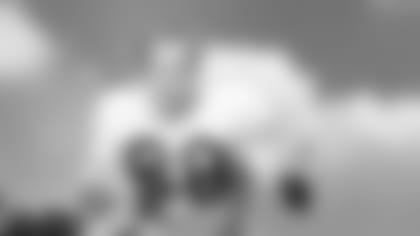
I heard Matthew McConaughey say on a nationally televised program that his father played for the Packers in 1953. I couldn't find any info to support his statement. Can you help?
The Packers drafted James McConaughey in the 27th round in 1953, but he never played for them, not even in any of their five preseason games that year.
James McConaughey lettered at the University of Houston in 1951 and 1952. He had started out at the University of Kentucky when Bear Bryant was there and participated in an intrasquad game in 1949, but never lettered.
When the Packers signed McConaughey in late May 1953, they expected him to compete for a starting job at defensive end following the retirement of Abner Wimberly, who had been one of the Packers' three Pro Bowl picks in 1952.
The Packers held their training camp that summer in Grand Rapids, Minn. The Green Bay Press-Gazette reported McConaughey arrived in Green Bay on July 24, three days before the start of practice. The next day, the paper listed him on the camp roster and noted he was one of several players who had attended a pre-camp workout at Green Bay's City Stadium. On July 26, the players spent the day traveling by bus to Grand Rapids. On Aug. 1, James McConaughey's name appeared in the Press-Gazette for the last time.
Although the Packers scrimmaged several times that first week, McConaughey wasn't mentioned among the defensive ends competing for a job. On Aug. 7, the lineups were listed for an intrasquad game scheduled for that evening in Duluth and McConaughey wasn't listed.
Back then, not every player who got cut or left camp was named in the paper. But, according to the NFL office, the Packers officially waived McConaughey on Aug. 14, 1953, eight days before their first preseason game.
Interestingly, when the Packers signed James McConaughey, the Press-Gazette noted that his father, Hugh McConaughey, had been a football star at Texas A&M nearly 30 years earlier. However, the Aggies don't list Hugh McConaughey among their all-time football lettermen.
Randy from Tyler, TX
As a follow-up to your list of players whose careers were affected by injuries, my understanding is Mark D'Onofrio of Penn State could have been a special player, but had a career-ending injury. Do you have any opinion on the guy?
D'Onofrio was a linebacker and the second pick in Ron Wolf's first draft in 1992. He started the first two games as a rookie and was credited in the next year's Packers media guide with four unassisted tackles and five assists. But in the fourth quarter of the second game, a 31-3 drubbing at the hands of Tampa Bay, D'Onofrio tore his left hamstring and subsequently had to have surgery on it.
Domenic Gentile, who was then the Packers' athletic trainer, said it was "the worst hamstring injury I've seen in my 32 years as a trainer." Not surprisingly, it also was career-ending.
What I can tell you is that Wolf thought D'Onofrio was going to be a special player and Mike Holmgren liked him, too.
"I think he would have been outstanding," Wolf told me in 2005. "What a freakish injury. But we'll never know."
Living in Texas, you may know that D'Onofrio is starting his first season as defensive coordinator at the University of Houston.
Brian from Rockford, IL
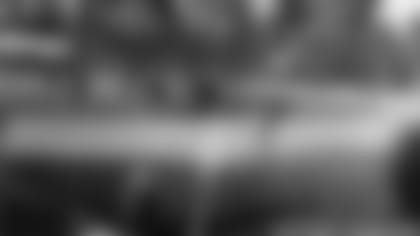
On Oct. 2, 1921, the Packers beat the Rockford Maroons, 49-0, in a preseason game. The other teams the Packers played in the 1921 preseason were the Chicago Boosters, Chicago Cornell-Hamburgs and Beloit Fairies. If these "Maroons" were from Rockford, does any information from the game exist?
Sure, there's plenty to research. I had the Press-Gazette stories about the game in my files, but earlier this year, I went to the library in Rockford and searched for stories in the Rockford papers. That's why it has taken me two years to answer your question.
Anyway, 1921 was the Packers' first season in the American Professional Football Association, or what became the NFL the next year. Also, that was decades before the NFL coined the term "preseason game." They were merely called non-league games – that is if the local papers even bothered to identify them as such.
In 1921, the APFA had no master schedule. Sometimes teams lined up games from week to week. The Packers didn't play their first league game until Oct. 23 and that may have been because they couldn't afford to play on the road and they had trouble finding enough league teams willing to come to Green Bay. My hunch is that's why they started with four non-league games at home.
The Press-Gazette touted the Rockford Maroons as champions of northern Illinois and a team that had lost only two games in six years.
However, the three Rockford papers – The Rockford Register-Gazette, the Rockford Republic and The Rockford Morning Star – all referred to the team as the Olympics.
Not unlike other team managers of the day, Rockford's Wilton Floberg also covered the trip for the Register-Gazette. The day before the game, he wrote that 18 Rockford players were making the 191-mile trip to Green Bay in four automobiles and had left early that Saturday afternoon. In his story the day after the game, Floberg wrote, "All of the Olympic players were tired out when they reached Green Bay (Sunday) morning." He added, the players were "required to sit up all night."
The Republic offered its readers the same excuse for the Olympics, who were outscored by the Packers 28-0 in the fourth quarter. It noted they had "made the long trip to Green Bay by auto, not arriving there until early Sunday morning, and were forced to play the game without much sleep." The lead in the Morning Star the day after the game began, "Tired and travel worn by an all-night journey to the site of the battle…"
Even the Press-Gazette reported, "The visitors were beat before they started the game. That is so far as condition was concerned. They traveled by auto from Rockford and were sixteen hours on the road."
Today, Rockford to Green Bay would be maybe a 3½-hour drive, which makes me wonder if Green Bay's thriving speakeasies and bordellos didn't score one of their many alleged Prohibition-era victories. Or maybe the Rockford traveling party gave in to the temptations of one of Green Bay's neighboring cities, many of which didn't pay heed to the country's liquor ban, either.
We'll never know, but to Rockford's credit, it otherwise left a favorable impression on its hosts. The Press-Gazette praised it for being "a game bunch," and "not beefers," like the Chicago Boosters had been.



